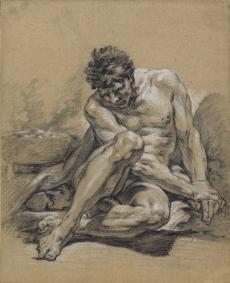


One of the duties of those who had reached the grade of professeur or adjoint à professeur at the Académie Royale de Peinture et de Sculpture was to pose the male model or models (they were sometimes paired) for the more advanced students to draw from. The poses were sometimes taken from well-known paintings, but more often thought up by the professors themselves – occasionally to serve for a figure in one of their own pictures. Once the serious collecting of contemporary drawings became more general in France in the second third of the 18th century, however, certain artists, above all François Boucher and Carle Vanloo (1705-1765), began to make such drawings to be collected: either directly, or in the form of engravings after them.
It can, therefore, be quite a ticklish matter to discriminate between the numerous académies – as such drawings are called – that have survived. Some are by the professors; others, which have a professor’s name on, may be by a student, recording on his drawing the name of the professor who had set the model’s pose and the date of the session; others again may represent an earlier stage of learning: a pupil copying a professor’s académie, and bearing the name of the professor, rather than his own. The drawings of the professors themselves can differ in kind: some, that simply record a pose, may represent academic instruction; others, with indications of a setting, and the models presented as river gods or in some other guise, were more probably made to be collected and/or engraved. Dating académies can also be difficult, but the recurrence of the same model can provide some date brackets.
The present drawing is of a model frequently depicted by Boucher, from when he was nominated a professor at the Académie in July 1737, along with Vanloo and Charles-Joseph Natoire (1700-1777), and on into the 1750s. He appears in an académie in the École Nationale Supérieure des Beaux-Arts in Paris that is inscribed with Boucher’s name and Professr au mois de 9 bre 1739. Boucher’s name has the form of his signature on documents – but does it denote his authorship, or his approval of a student’s effort, in November 1739? The model appears in another drawing that also bears what appears to be Boucher’s signature, along with the date 1738, and an additional inscription, Acad. Roy. N. XII. This denotes it as having once belonged to the Académie Royale, removing any possibility of doubt as to its authorship. Interestingly, however, it shows the model in a quite detailed setting; it was, therefore, a drawing that could have been a collector’s item, had Boucher not deposited it with, or donated it to, the Académie. The Académie in turn sent it, as one of 21 such académies, to the École Académique of Marseilles, two years after its foundation.
The present drawing only has slight indications of a setting, and has something like a large pan or bowl in the background on the left. As so often, the model looks serious – even anguished. Yet the pose does not look like one taken from, or adopted for, a painting. Rather, the clamping of one hand over the other looks like a way of ensuring that the model could hold the pose of his body for as long as possible. The drawing looks like a good example of one of the académies that Boucher produced for collectors, rather than for instruction.
He probably trained initially with his father, Nicolas Boucher, a minor artist, in Paris. Amongst the most prolific artists of his time, he worked in practically every medium and genre, advocating a mature Rococo style that was extensively disseminated in prints and via his many designs for the decorative arts. From being professor at the Académie Royale (from 1737) and head of the Gobelins tapestry works (1755), he was appointed Premier Peintre du Roi in 1765. His principal patron was Madame de Pompadour, mistress of Louis XV.